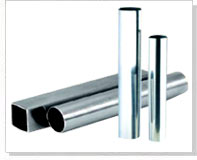 Metal tubes are usually lengths of pipe or tubing, plugged or spun closed and welded. These tubes are generally made of metallic elements or alloys and are engineered for specific industrial applications. Metal tubes can be constructed of several materials including brass, aluminum, copper, bronze, titanium, gold, silver, platinum, steel, and stainless steel.
Metal tubes are usually lengths of pipe or tubing, plugged or spun closed and welded. These tubes are generally made of metallic elements or alloys and are engineered for specific industrial applications. Metal tubes can be constructed of several materials including brass, aluminum, copper, bronze, titanium, gold, silver, platinum, steel, and stainless steel.
In terms of function, metal tubes can be categorized into two types -
- Electrical metal tubes
- Mechanical metal tubes
Electrical tubes are used to hold and contain electrical wires, while mechanical tubes have stronger cross-sections and are designed for structural applications. Dimensional stipulations for these metal tubes are - inside diameter (ID), outside diameter (OD), and wall thickness. Some metal tubes have round or oval-shaped cross-sections, while some have square or rectangular.
For pneumatic applications, there are two types of metal tubes -
- Compressed air tubes
- Vacuum tubes
Selecting Metal Tubes
Selection of metal tubes require an analysis of performance specifications such as pressure rating, maximum vacuum, minimum bend radius, and temperature range. Graded pressure is the short-term burst pressure at 75° F. Maximum rated vacuum is generally given in inches or millimeters of mercury cited below one standard atmosphere (atm).
Minimum bend radius is grounded on the acceptable cross-section deformation for metal tubing. Temperature range is of the complete required range of ambient operating temperatures.
Collapsible metal tubes are widely used for packaging a broad range of pharmaceutical and cosmetic creams, pastes, ointments, jellies and semi-liquids.
Metal tubes are impermeable to gas, moisture, odor and light, provided they are closed in an adequate manner. These tubes have found to be convenient and useful for patients and as the content are expelled by squeezing the tube, there is no tendency for the walls to retain their original shape when the pressure is released. Accordingly, the risk of air entering the pack and reacting with the product or causing it to dry out is minimized. Internal coating may be essential to prevent chemical reaction. The combined properties of collapsibility and impermeability are advantages over most of the plastic tubes that are not only permeable but also tend to snap back into their original shape after every application.
Tin is the least reactive of available metals, is very bright and is also non-toxic. However, it is pretty expensive and therefore its usage is restricted to pharmaceuticals, such as antibiotic and some opthalmic ointments where maximum protection is required. Nowadays, most of the collapsible tubes are made from aluminum that is relatively cheap but subject to certain alkaline or acidic products. Its widespread use has been made possible by the development of internal coating systems that are sprayed into the tube promptly after forming it.
ApplicationsSome of the common industrial applications of metal tubes are -
- Aerospace and aircraft
- Automotive
- Chemical
- Coolant
- Cryogenic
- Food and beverage processing
- High purity, high temperature and high viscosity applications
- Hydraulic fluid
- Salt water
- Medical
- Pharmaceutical
- Peristaltic pumping
- Refrigeration
- Sanitary, and slurry
Features
Metal tubes differ in terms of designs and features. Some important features of different metal tubes are -
- Anti-static tubes are designed to prevent the buildup of static electricity.
- Coiled / spiral tubes are flexible with long, continuous runs.
- Corrugated tubes provide pleats for enhanced flexibility and compression capacity.
- Metal tubes also come in the form of explosion-proof, finned, multi-element, and multi-layered.
- Reinforced tube uses fibers or banding.
- Spark resistant metal tubes are engineered to sustain integrity in the presence of electrical discharge or sparking.
- Seamless, welded, and welded and drawn (WD) metal tubes have found to be useful in many different applications.
